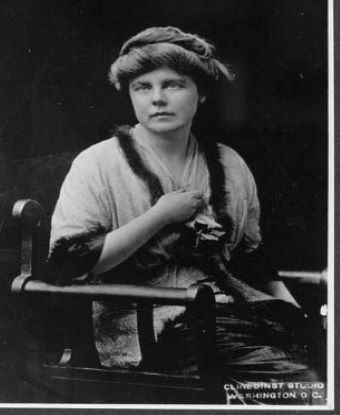Last updated: August 7, 2024
Person
Lucy Burns

National Woman's Party records, Library of Congress
"Resistance to Tyranny is Obedience to God"
Lucy Burns, tall and red-haired with bright blue eyes, was a fierce fighter in the cause for woman suffrage. She carried a banner emblazoned with the slogan shown above when she led a procession of women through a train yard in 1919. All the women had served time in jail for protesting in support of woman suffrage. The women of the “Prison Special” railroad tour of the country wore drab, baggy dresses similar to the uniforms they were forced to wear when they were imprisoned. It was fitting that Lucy led them, since she had spent more time in prison than any other American woman suffragist.
Lucy Burns was born into a large Irish Catholic family in Brooklyn, NY in 1879. After graduating as a top student from Vassar College in 1902, Burns attended graduate school in Europe. She was attending Oxford College when she encountered the militant “suffragettes” of the Women’s Social and Political Union (WSPU) led by Emmeline Pankhurst and her daughters. Lucy left her studies to join the WSPU and participate in their confrontational demonstrations demanding women’s right to vote. She was arrested several times along with other protestors. In a London police station in 1909 she met fellow American Alice Paul, who had also joined the WSPU actions. They became good friends. Alice left Europe in 1910, but Lucy stayed on to lead the WSPU campaign in Scotland.
After Lucy returned to the United States, she and Alice teamed up to bring new energy to the American woman suffrage movement. They moved to Washington, D.C. in 1912 to lead the Congressional Committee of the National American Woman Suffrage Association (NAWSA.) The committee’s job was to work for an amendment to the US Constitution enfranchising women. Before Lucy and Alice took over, the committee had accomplished very little. The first action organized by the new committee leaders was a Woman Suffrage Procession down Pennsylvania Avenue in Washington, D.C. on March 3, 1913, the day before Woodrow Wilson’s presidential inauguration.
Although the procession brought positive attention to the woman suffrage movement, Burns and Paul soon had a falling-out with the NAWSA leadership. They broke away and formed their own organization, the Congressional Union for Woman Suffrage (CU) in 1914. The CU became the National Woman’s Party (NWP) in 1916. The strategy that Burns and Paul developed for both the CU and the NWP included building support for the amendment through actions that would gain national publicity. Lucy Burns became the editor of their publication, The Suffragist, which was distributed across the country. Her editorials were powerful and well-argued. She was a passionate, charismatic speaker who fired up large audiences but she could also be diplomatic and calming when necessary. She had a particular talent for organizing large actions like a campaign across the West during the 1916 election season.
Lucy also became the leader of the NWP’s most prominent and controversial campaign. Women began picketing the White House in January 1917, demanding that President Woodrow Wilson support the federal amendment to the Constitution. The picketers stood at the White House gates all day for months holding large banners that asked “What Will You Do for Woman Suffrage?” and “How Long Must Women Wait for Liberty?” Public opinion turned against the picketers when they continued the protest after the U.S. entered World War I. Rather than back down, Lucy became even more provocative. On June 20, 1917, she and Dora Lewis carried a banner accusing the president of deceiving the world when he spoke about democracy. Crowds began to gather and attack the picketers. The police threatened the NWP with arrest if they continued the protest. They persisted. Two days later, Lucy and Katherine Moray were arrested.
Over the next several years, hundreds of women faced arrest for participating in the NWP protests. Lucy was arrested six times, sometimes serving months in prison. One sentence included the “Night of Terror” at the Occoquan Workhouse on November 14-15, 1917. Women were beaten and tortured throughout the night. Prison guards handcuffed Lucy’s arms above her head and left her that way all night long. Lucy led the prisoners on hunger strikes to protest their treatment. She endured brutal force-feeding.
Lucy and the other members of the NWP did not stop protesting after their release from prison. They didn’t let up the pressure after Wilson finally spoke out in support of the suffrage amendment in 1918. They continued fighting for the right to vote and planned tours around the country to tell their stories, including the “Prison Special” tour in early 1919. A few months later, Congress passed the amendment in June 1919. The Nineteenth Amendment became part of the U.S. Constitution on August 26, 1920.
Lucy Burns retired from public life after victory in the woman suffrage fight. Although Alice Paul continued to work for women’s equality until her death in 1977, Lucy returned home to Brooklyn. She explained, “I don’t want to do anything more. I think we have done all this for women, and we have sacrificed everything we possessed for them, and now let them fight for it now. I am not going to fight anymore.”
Sources include: Library of Congress, Vassar Encyclopedia, and J. D. Zahniser and Amelia Fry, Alice Paul: Claiming Power (2016).
